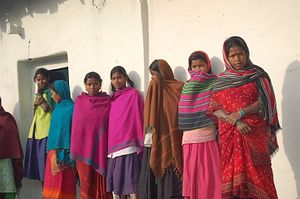Less than two years after the fatal gang rape of a young woman on a bus in South Delhi, photos of a fashion shoot glamorizing the heinous event emerged. How photographer Raj Shetye, or the models involved in the series entitled “The Wrong Turn,” thought it was even remotely palatable — or, as he said, “just a way of throwing light on” the brutal death of a 23-year-old physiotherapy intern — is as tragic as it is perplexing. Yet for a nation where a woman is raped every 13 minutes, the attitude is almost symbolic.
India’s rapid opening to the world over the past three decades has created a profound identity crisis, which has left the nation in a state of social and cultural angst on innumerable affairs. As for Indian women, they’ve found themselves locked between a traditional yet patriarchal society on one hand and a liberal yet exploitative one on the other.
Old India
The nation is yet to fully emerge from deeply inbuilt gender stereotypes. Based on demographic projections, its estimated that India is “missing” over 63 million girls due to infanticide and better care for younger boys. Indeed, particularly in poorer rural parts of the country, girls largely continue to be seen as a burden. Dowry practices, while illegal, remain rife, and many communities still cannot envision a woman’s role beyond domestic life. Inherently, from an early age, a girl is considered a cost and subordinate to a boy. Males, instead, are upheld as potential breadwinners, which means young boys often grow up in a milieu which sees them as superior to girls.
A combination of economic uplift and sociocultural introspection is required before these attitudes change across India, particularly in its traditional hinterlands. Of course, in many modern cosmopolitan urban centers there is a parity of esteem between men and women across most walks of society. That said, new challenges have emerged as different parts of the country have “liberalized.” Indeed, the much welcomed push toward gender equality, and female free expression, appears in places to be exploited, particularly by Indian media. The changing portrayal of women in Bollywood over the past three decades is indicative.
New India
In the 1990s females were typically cast as meek damsels in distress or maternal figures, while in recent years — as audiences have “westernized”—there’s been a growing trend toward sexualizing (often excessively) young Bollywood actresses. There’s been an explosion of so-called “item numbers” in films since 2000, which usually involve attractive starlets performing a risque song-and-dance sequence. Many films have relied on those scenes for their sales. Film directors know sex sells in modern India.
For critics, this is objectification; for others, it’s a celebration of the female form. But for many younger men and older generations who lack the maturity that modern liberal attitudes to women demand, such scenes are quite likely to be dangerously misinterpreted. Many cannot square the modest traditionally dressed women they are used to with what they see on their screens. And, coupled with an inbuilt sense of superiority over women, it harbors a potent mix of degradation and sexual frustration.
The internet has only rubber-stamped what the film industry has started. In a nation where more people have a mobile phone than a toilet, viewership of sexual material and pornography has exploded. With streaming becoming particularly popular, Netflix’s first Indian drama series, “Sacred Games,” drew significant interest for its sex scenes. Sex is often considered a taboo subject, particularly in family settings, and researchers have suggested pornography, films, and conversations with peers have plugged the vacuum in “sex education” for young Indians.
The Future
Building awareness is the first step forward. Taboos around gender equality and sexual health must be broken at schools, on university campuses, in the home, and in public fora. That needs to be combined with a national sex education and information campaign targeting young males. At the same time a concerted effort to level the playing field in economic opportunity for women will also be integral to shifting attitudes, as will improving the justice mechanisms, policing, and support available for victims of sexual violence.
Policy needs to move forward quickly. Recently, India was ranked the most dangerous place to be a woman, followed by Afghanistan, Syria, Somalia, and Saudi Arabia, given the high rate of sexual assault. For Hindu nationalists that result may only feed their narrative that India must revert back to the conservatism of the past, and the traditional views of gender that come with it, rather than nurturing modern attitudes toward women.
But if nuanced and honest discussions about India’s cultural challenges are sidelined, there will only continue to be a naive and apathetic stance toward the plight of women in India.
Tej Parikh is a global policy analyst and journalist. He tweets@tejparikh90 and his work is archived at The Global Prism.

































